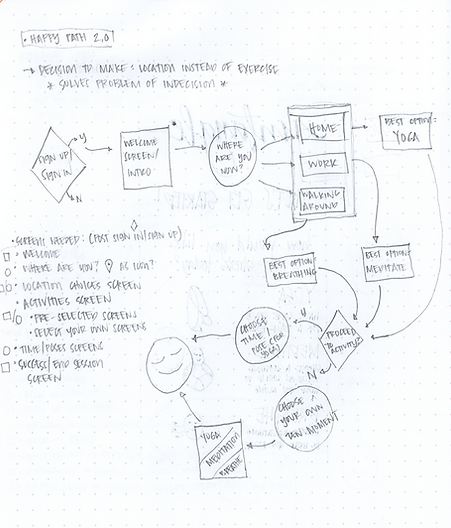
Untangled was my final project for the User Experience Design 10-week course I took at General Assembly.
Project Overview
Throughout the 10-week course, we were given a step-by-step run through of the different modules that make up the UX process. Our goal: to present a final project of our own creation at the end of the 10 weeks using everything we learned during the course.
My project, Untangled, centers on easy mini-mindfulness fixes to de-stress.
PROBLEM
STATEMENT
People tend to react and deal with stress in a negative way – to confront, vent – without actually dealing with the cause/issue. This may lead to letting that negativity build up and cause more chaos instead of getting it resolved.
HYPOTHESIS
I believe that mindfulness is a great way to de-stress and assess difficult situations that can bog down your mood.
Whether alone or with a group of people, in a quiet space or amongst friends, pulling yourself out of the negative space and into a thoughtful one can help not just relieve stress but also possibly get your frustration under control, or even resolve what stressed you out in the first place.
RESEARCH + INSIGHTS
Research Goals
I centered my "stress'-search with the following questions:
• What does "stress" mean to people?
• Why do people get stressed?
• How do people normally react to and deal with stress?
Research Highlights
After interviewing 30 people in the course of 3 weeks, here's what I found:
• Stress is very personal and surprisingly difficult to define
• Biggest stressor: us humans (and sometimes traffic for those who drive a lot)
• Dealing with stress without being mindful can actually be toxic in the long run
The most common feedback:
Meditation and yoga can be intimidating to a lot of people who have little knowledge about these mediums

COMPETITIVE ANALYSIS
After the interviews, I immersed into the world of Mindfulness and Meditation 101 via my iPhone. My goal was to find apps that were easy to navigate and accessible.
Besides trying to find the unique qualities of each app, I wanted to find out how they can each be effective and ineffective in the de-stressing process.

USER FLOW
After testing different live apps, I wanted to create the most simple yet effective User Flow for my project.
Since the majority of people I interviewed felt intimidated by the concept of mindfulness exercises, I decided to remove the habit-forming concept of the typical mindfulness app and instead focused on making my app's mindfulness exercises more bite-sized, thus easier to digest.
This concept created a less daunting experience for the user.

SKETCHES + PROTOTYPE
Low + High Fidelity Sketches
I wanted to make sure that the simplicity of the flow extended to its design in order for the user to have a no-fuss feeling when using the app.
One of my first happy paths for the project is outlined on the right: it centers on the location of the user as the main "decision-maker" of the kind of mindfulness session they can try.
Although the idea of picking the location for the user seemed to, at first, make it easy for them to then do a mindful exercise, it also became a deterrent in that if they are not in any of the three locations provided, they may abandon the exercise and app altogether.


I toggled between these two main screen designs:
The screen on the left centered on the "what" - three types of mindfulness mediums the user can choose from, while the screen on the right centered on the "where" - the location they were currently in when they first open the app.
The sharp edges and points on the three tabs of the first screen felt anxious and forceful, counterintuitive to relaxing. On the other hand, the rounded icons on the second design felt less aggressive and more inviting, and became the prominent design feature of my app.
Here are a few other sketches I designed for this project. The colored sketches are the slices I used for usability testing on the Sketch Mirror and Marvel iPhone apps before going live with my final prototype.
Click here for my Final Prototype!




THE FUTURE OF UNTANGLED
Even though this was only a class project, I saw the benefit to a mindfulness app like the one I created. Here's where I see Untangled can go even further:
* Videos vs. Photography vs. Vector: creating more interactive experience with videos of actual yogis and meditation coaches, or more robust photography may be esthetically pleasing and more inviting to tech-savvy users
* An Incentive Program, like exclusive live guided meditation on your 10th completed session within the app, could help generate more users to try these exercises and also help wellness instructors grow their businesses
* Affiliations with quiet rooms or the Mindfulness Truck (in NYC) can help shy starters to broaden their newfound practice to de-stress
* Food aspect - snacks to help de-stress? This may be a great way to help people that tend to rely on food as a comforting solve whenever they are stressed to pick healthier, more mind-body-and-soul healthy

Personal thoughts on this project
This project and the 10-week UX program gave me such a great sense of pride and freedom in my thinking and creativity.
It helped me give a name to the bits and pieces of processes and tasks I've been doing in spurts during the different hats of my career: in Customer Service, Online Marketing, Brand Merchandising, and Digital Asset Operations.
It truly opened up a new way of thinking about the future of my career and where I want to go in life: into the world of UX.